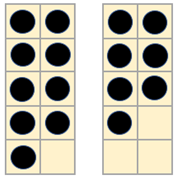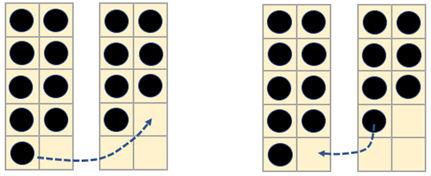Purpose
The purpose of this activity is to support students learning the most difficult addition basic facts to 20, meaning those that are not easily derived from doubles or teen number knowledge. These facts have sums in the range 11-19, such as 8 + 6 = 14 and 7 + 9 = 16.
Achievement Objectives
NA2-3: Know the basic addition and subtraction facts.
Required Resource Materials
- Counters (circular, square or novelty counters)
- Blank tens frames (use page 2 of Material Master 4-6)
- Masking card (A5 size is good)
Activity
- Choose a difficult addition fact to 20 to learn. For example, use 9 + 7. Set up the counters model. Consider whether it will be sufficient to model this for your students, or whether individuals need the opportunity to use the counters and model each addition fact.

- Ask: What other basic addition facts have the same answer as 9 + 7?
Students might suggest that 8 + 8 and 10 + 6 have the same answer. Fold back to the materials to see why those relationships are correct. Be open the students seeing other relationships such as 9 + 7 = 6 + 6 + 4 or 9 + 7 = 5 + 5 + 6.
9 + 7 = 8 + 8 9 + 7 = 10 + 6
- Use a similar process to support the learning of other difficult facts with sums in the range 11-19:
6 + 9, 8 + 9, 6 + 8, 7 + 6, 9 + 3, 3 + 8, 8 + 3, 7 + 6, 6 + 8, 8 + 9.
This might be done in pairs or small groups. Provide time for students to share their thinking with the wider class.
- Provide students with lots of opportunities to practise and learn the facts, and to express their mathematical thinking in different ways (e.g. online tasks, written, verbal, drawn diagrams, acting out, using physical manipulatives). There are many online learning objects that practise facts in an entertaining way. Use games like Four in a row addition, Bunches, and Twenty-seven, to support students to learn the basic facts. You might use addition contexts or stories that are relevant to your students' interests, cultural backgrounds, and/or current learning from other curriculum areas. Support the use of relevant mathematical language and te reo māori kupu (e.g. tāpiri - add/addition).
Next steps
- Give students missing addend problems that involve more difficult addition facts in word and symbolic form. For example:
- Seven and what makes 16? 7 + __ = 16
- Five and what makes 13? 5 + __ = 13
- Eight and what makes 15? 8 + __ = 15
- Connect addition facts to subtraction. For example:
- If 9 + 6 = 15, what is 15 – 6?
- If 8 + 7 = 15, what is 15 – 8?
- If 4 + 8 = 12, what is 12 – 8?
- Begin with a known addition fact and ask students to create a web of connected facts. For example:

Add to plan
Level Two